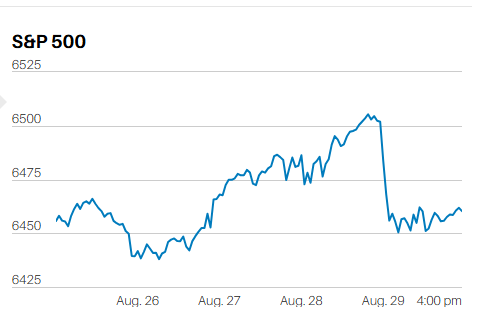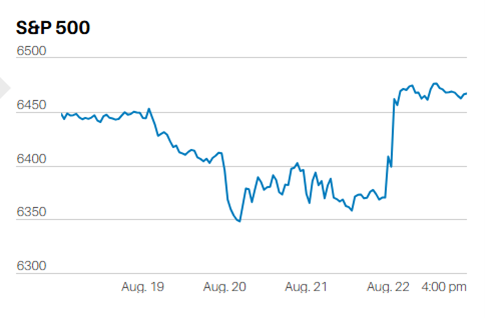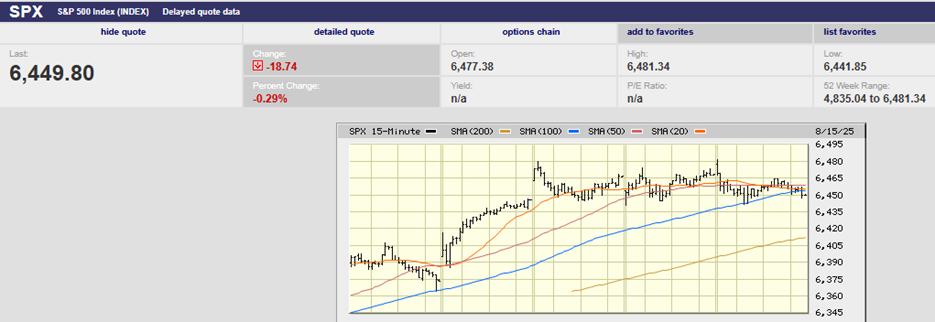Tax deferrals are important for Cash Balance and 401(k) plans

Market Update
The S&P 500 lost 2.8% last week to close at 4271.78. The Nasdaq dropped 3.8% continuing its underperformance on the year. The S&P is down 10.4% in 2022. The Nasdaq is down almost 18%. We wrote last week that the S&P 500 could test the low end of its trading range within the next few weeks. A test of support seems even more likely now. The index only needs to fall another 2% to drop below 4200. The low for the year came on 24 February when the S&P hit 4114.65. The index needs to fall another 157.13 points or 3.7% to take out that low.
Norwood Economics believes the bottom of the trading range will hold, but it might not. Next support is the big round 4,000 number. There is also support at 3900 which is the bottom of a descending channel. A clear break below 4114.65 would open the door for a quick decline to 3900.
Pundits are blaming the sharp decline last week on the Federal Reserve's tough talk. It is mostly talk so far. The fed funds rate is only 0.25% - 0.50% and the Federal Reserve is still growing its balance sheet. A reversal to shrinking the balance sheet is only a promise. Board members are talking tougher though. Several said last week a 0.5% hike is on the table. James Bullard of the St. Louis Fed talked about 0.75% as a possibility. The Fed hasn’t raised by 0.75% since 1994.
The fed funds futures market is pricing in a half-point hike next month. It is also pricing in a three-quarter point hike at the June 13-14 FOMC meeting and a half-point hike in July. The probability of the federal funds rate rising to 2.00%-2.25% by July is now 87%, according to CME FedWatch. The probability of rates rising that fast was only 16% a week earlier.
Bonds meanwhile continued to lose money. The two-year Treasury note rose 0.27% last week to 2.713%. The 10-year note was up .097% to 2.905%. The Bloomberg Barclays Aggregate Bond index is down 9.37% YTD. The index represents the total U.S. investment-grade bond market. The 20+ U.S. Treasury bond ETF is down 18.69% on the year. The Vanguard Balanced Index Fund is down 10.34% year-to-date. The Balanced Index fund is a 60/40 stock and bond portfolio. Bonds are supposed to hedge against losses in stocks. Bonds are not serving as a hedge in 2022 as both stocks and bonds are losing money.
It has been a difficult four months for investors. Still, Norwood Economics continues to forecast a stock market that ends flat to down 10% for 2022. We do not see a bear market this year because we do not see a recession in 2022. A recession is more likely in 2023. We do expect plenty of volatility throughout the rest of the year.
Economic Indicators
Building permits in March stayed flat at 1.87 million. It was above expectations of 1.82 million. Housing starts were also flat at 1.79 million. Expectations were for 1.73 million. Existing home sales fell to 5.77 million in March from 5.93 million the prior month. Rising mortgage rates are having an impact on home buyers. Homebuilder stocks fell in the first quarter. They were bouncing in April until last week when they reversed lower. The sustained decline in the first quarter came as investors worried about the impact of rising mortgage rates. The housing market serves as a catalyst for many related industries and is an important part of the U.S. economy.
The weekly jobless rate was under 200,000 again, clocking in at 184,000. The prior week's jobless claim number was 186,000. Last week’s number remains near a 54-year low. Meanwhile, the Leading Economic Indicators (LEI) number was 0.3% in March, down from 0.6% in February. The LEI indicates slow growth for the economy ahead. Hoisington points to the fiscal cliff in 2022 and 2023 as a reason to be concerned about a recession in 2023. The Hoisington Q1 report is available on its website and is worth reading.
Tax Deferrals Have Real Economic Value
We’ve written about deferring taxes before. We are doing so again because of a conversation that happened this past week. The client does not understand the real value of deferring taxes for a decade or more. Accounting for tax savings matters in the analysis of the true cost of both 401(k) and cash balance plans. In this case, the conversation was about a cash balance plan. We’ll use a case study to illustrate.
Cash balance plans are a type of qualified retirement plan that works with an underlying 401(k) plan. We’ll spare you the details of how they work and focus on how to calculate the after-tax cost of the plan. The key point to understand is that the employer contributions are tax-deductible. Those deductions occur above the adjusted gross income line. Owners can often put $200,000 or more into a cash balance plan for themselves. The maximum for both the 401(k) plan and cash balance plan combined is more than $332,000 in 2022. People earning more than $250,000 are paying around 45% of that income in taxes. The 45% all-in tax rate includes federal, state, and local taxes as well as the 3.8% Medicare surtax if self-employed. The surtax is 2.35% if you receive employment wages. Tax savings on $332,000 is approximately $149,000.
The $149,000 is money you do not pay to the government, at least not yet. Instead, you get to keep it and invest it. The money you earn with the government’s money is yours to keep. Retaining $1.5 million over ten years and investing it at normal rates of return creates substantial additional wealth. Of course, there are expenses that will offset some of the tax savings. So, let’s look at real numbers from an actual plan.
The three-year cost of the plan is estimated at $281,000; much of the cost is contributions to employees. The three-year tax savings to the owner is estimated at $452,000. The net benefit to the owner is approximately $171,000. The net benefit is cash flow from the business not paid to the government. In other words, the owner's after-tax cash flow has gone up. The extra cash flow can be invested.
The plan in question has earned 8.55% over the trailing year and 8.03% annually since inception. The owner will have put $675,000 into the plan for himself at the end of three years. He will have put another $103,000 into his 401(k) plan than otherwise as well. Cash balance plans don’t work without the tax savings. They work very well in practice because of the tax savings. The same is true of 401(k) plans for small business owners. Tax deferrals have substantial value. They must be a part of the analysis when deciding whether to implement a cash balance plan and a 401(k) plan.
Regards,
Christopher R Norwood, CFA
Chief Market Strategist











